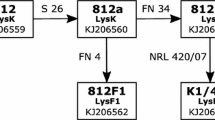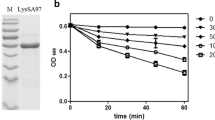Abstract
The novel phage lysin PlySs2, is reported to be highly active against various bacteria, including staphylococci, streptococci and Listeria. However, the molecular mechanisms underlying its broad lytic spectrum remain to be established. In the present study, the lytic activity of the catalytic domain (CD, PlySc) and binding specificity of the cell wall binding domain (CBD, PlySb) of PlySs2 were examined. Our results showed that PlySc alone maintains very limited lytic activity. Enhanced green fluorescent protein (EGFP)-fused PlySb displayed high binding affinity to the streptococcal strains tested, including S. suis, S. dysgalactiae, and S. agalactiae, but not staphylococci, supporting its utility as a good CBD donor for streptococcal-targeted lysin engineering. EGFP-fused intact PlySs2 similarly displayed high affinity for streptococci, but not staphylococci. Notably, four truncated PlySb fragments showed no binding capacity. These findings collectively indicate that integrity of the PlySc and PlySb domains is an essential determinant of the broad lytic activity of PlySs2.
Similar content being viewed by others
References
Ahluwalia AK, Sekhon BS. 2012. Enzybiotics: A promising approach to fight infectious diseases and an upcoming need for future. J Pharm Educ Res, 3: 42–51.
Briers Y, Walmagh M, Grymonprez B, Biebl M, Pirnay JP, Defraine V, Michiels J, Cenens W, Aertsen A, Miller S, Lavigne R. 2014. Art-175 is a highly efficient antibacterial against multidrug-resistant strains and persisters of Pseudomonas aeruginosa. Antimicrob Agents Chemother, 58: 3774–3784.
Briers Y, Walmagh M, Van Puyenbroeck V, Cornelissen A, Cenens W, Aertsen A, Oliveira H, Azeredo J, Verween G, Pirnay JP, Miller S, Volckaert G, Lavigne R. 2014. Engineered endolysin-based “artilysins” to combat multidrug-resistant gram-negative pathogens. MBio, 5: e01379–14.
Coello R, Jimenez J, Garcia M, Arroyo P, Minguez D, Fernandez C, Cruzet F, Gaspar C. 1994. Prospective study of infection, colonization and carriage of methicillin-resistant Staphylococcus aureus in an outbreak affecting 990 patients. Eur J Clin Microbiol Infect Dis, 13: 74–81.
De Lencastre H, Kristinsson KG, Brito-Avo A, Sanches IS, Sa-Leao R, Saldanha J, Sigvaldadottir E, Karlsson S, Oliveira D, Mato R, Aires de Sousa M, Tomasz A. 1999. Carriage of respiratory tract pathogens and molecular epidemiology of Streptococcus pneumoniae colonization in healthy children attending day care centers in Lisbon, Portugal. Microb Drug Resist, 5: 19–29.
Dong Q, Wang J, Yang H, Yu J, Zhang Y, Huang Y, Zhang XE, Wei H. 2014. Construction of a Chimeric Lysin Ply187N-V12C with Extended Lytic Activity against Staphylococci and Streptococci. Microb Biotechnol, 1–11.
Fischetti VA. 2003. Novel method to control pathogenic bacteria on human mucous membranes. Ann N Y Acad Sci, 987: 207–214.
Fischetti VA. 2010. Bacteriophage endolysins: A novel anti-infective to control Gram-positive pathogens. Int J Med Microbiol, 300: 357–362.
Gilmer DB, Schmitz JE, Euler CW, Fischetti VA. 2013. Novel bacteriophage lysin with broad lytic activity protects against mixed infection by Streptococcus pyogenes and methicillin-resistant Staphylococcus aureus. Antimicrob Agents Chemother, 57: 2743–2750.
Junjappa RP, Desai SN, Roy P, Narasimhaswamy N, Raj JR, Durgaiah M, Vipra A, Bhat UR, Satyanarayana SK, Shankara N, Basingi SM, Bhat JJ, Hariharan S, Sriram B, Padmanabhan S. 2013. Efficacy of anti-staphylococcal protein P128 for the treatment of canine pyoderma: potential applications. Vet Res Commun, 37: 217–228.
Loessner MJ, Gaeng S, Scherer S. 1999. Evidence for a holin-like protein gene fully embedded out of frame in the endolysin gene of Staphylococcus aureus bacteriophage 187. J Bacteriol, 181: 4452–4460.
Lukacik P, Barnard TJ, Keller PW, Chaturvedi KS, Seddiki N, Fairman JW, Noinaj N, Kirby TL, Henderson JP, Steven AC, Hinnebusch BJ, Buchanan SK. 2012. Structural engineering of a phage lysin that targets gram-negative pathogens. Proc Natl Acad Sci U S A, 109: 9857–9862.
Mao J, Schmelcher M, Harty WJ, Foster-Frey J, Donovan DM. 2013. Chimeric Ply187 endolysin kills Staphylococcus aureusmore effectively than the parental enzyme. FEMS Microbiol Lett, 342: 30–36.
McGowan S, Buckle AM, Mitchell MS, Hoopes JT, Gallagher DT, Heselpoth RD, Shen Y, Reboul CF, Law RH, Fischetti VA, Whisstock JC, Nelson DC. 2012. X-ray crystal structure of the streptococcal specific phage lysin PlyC. Proc Natl Acad Sci U S A, 109: 12752–12757.
Nelson D, Schuch R, Chahales P, Zhu S, Fischetti VA. 2006. PlyC: A multimeric bacteriophage lysin. Proc Natl Acad Sci U S A, 103: 10765–10770.
O’Flaherty S, Ross RP, Coffey A. 2009. Bacteriophage and their lysins for elimination of infectious bacteria. FEMS Microbiol Rev, 33: 801–819.
Pastagia M, Schuch R, Fischetti VA, Huang DB. 2013. Lysins: the arrival of pathogen-directed anti-infectives. J Med Microbiol, 62: 1506–1516.
Schuch R, Lee HM, Schneider BC, Sauve KL, Law C, Khan BK, Rotolo JA, Horiuchi Y, Couto DE, Raz A, Fischetti VA, Huang DB, Nowinski RC, Wittekind M. 2014. Combination therapy with lysin CF-301 and antibiotic is superior to antibiotic alone for treating methicillin-resistant Staphylococcus aureus-induced murine bacteremia. J Infect Dis, 209: 1469–1478.
Singh PK, Donovan DM, Kumar A. 2014. Intravitreal injection of the chimeric phage endolysin Ply187 protects mice from Staphylococcus aureus endophthalmitis. Antimicrob Agents Chemother, 58: 4621–4629.
Veiga-Crespo P, Ageitos JM, Poza M, Villa TG. 2007. Enzybiotics: A look to the future, recalling the past. J Pharm Sci, 96: 1917–1924.
Villa TG, Crespo PV eds. 2010. Enzybiotics: Antibiotic enzymes as drugs and therapeutics. Hoboken, New Jersey: John Wiley & Sons, pp107–122.
Yang H, Yu J, Wei H. 2014a. Engineered bacteriophage lysins as novel anti-infectives. Front Microbiol, 5: 542.
Yang H, Zhang Y, Yu J, Huang Y, Zhang XE, Wei H. 2014b. Novel chimeric lysin with high-level antimicrobial activity against methicillin-resistant Staphylococcus aureus in vitro and in vivo. Antimicrob Agents Chemother, 58: 536–542.
Yang H, Wang DB, Dong Q, Zhang Z, Cui Z, Deng J, Yu J, Zhang XE, Wei H. 2012. Existence of separate domains in lysin PlyG for recognizing Bacillus anthracis spores and vegetative cells. Antimicrob Agents Chemother, 56: 5031–5039.
Yoong P, Schuch R, Nelson D, Fischetti VA. 2004. Identification of a broadly active phage lytic enzyme with lethal activity against antibiotic-resistant Enterococcus faecalis and Enterococcus faecium. J Bacteriol, 186: 4808–4812.
Author information
Authors and Affiliations
Corresponding author
Additional information
These authors contributed equally to this work.
ORCID: 0000-0002-9948-8880
Rights and permissions
About this article
Cite this article
Huang, Y., Yang, H., Yu, J. et al. Molecular dissection of phage lysin PlySs2: integrity of the catalytic and cell wall binding domains is essential for its broad lytic activity. Virol. Sin. 30, 45–51 (2015). https://doi.org/10.1007/s12250-014-3535-6
Received:
Accepted:
Published:
Issue Date:
DOI: https://doi.org/10.1007/s12250-014-3535-6




